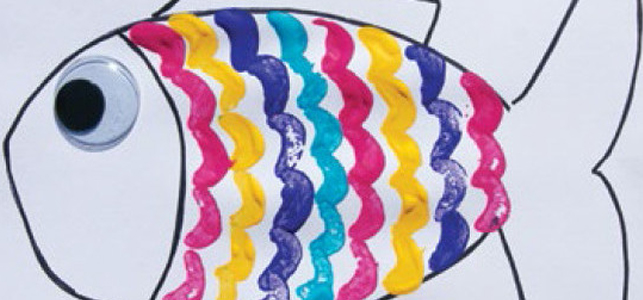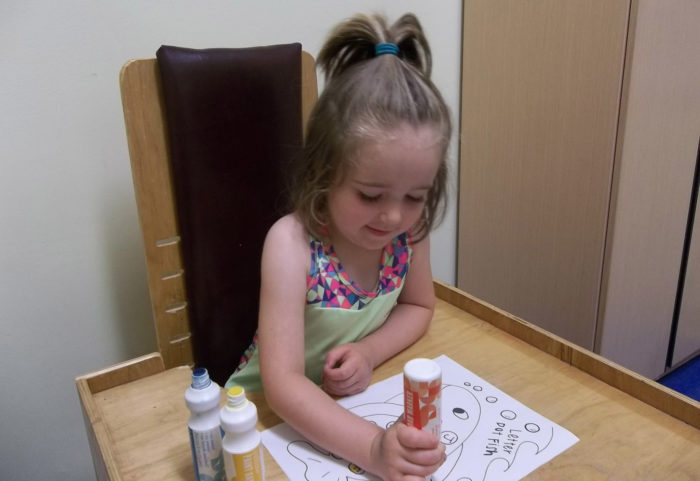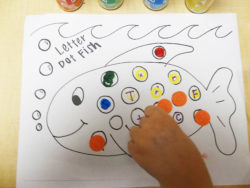
Summer language and reading development activities
Looking for worthwhile (and fun!) activities to fill those long summer days? Here’s one from speech-language pathologist Beth Wise. This letter-focused coloring activity combines learning and fun to help teach and reinforce important skills that are the basis for language and reading.
 “Letter Dot” Fish Fun
“Letter Dot” Fish Fun
This Letter Dot Fish template is ideal for helping a child learn to identify letters, letter sounds, and eventually words. It can be adapted and used for several different activities and goals.
For learning letters
The ability to identify the letters of the alphabet, a skill known as “print knowledge,” is a key component for the development of reading and language skills.
– Write one of the letters your child needs to learn or practice on each dot on the fish. You can include only capital letters, all lowercase letters or a mixture of both, depending on your child’s needs.
– Then, call out letters and have your child mark the letters you specify by coloring in the corresponding circles in different colors or marking them with stickers. (“Dot all the ‘f’s’ with an orange dot,” for example.) They can stamp the specific “letter circle” using a dot marker, color it in using markers or crayons, or even add ocean-themed stickers to show the dot that was selected.
– Working on letter patterns can help reinforce letter recognition and build a foundation for reading success. For practice identifying letter patterns, you might ask your child to “Mark all the vowels pink” or “Color all the lowercase letter ‘b’s’ with a brown crayon and uppercase with red.”
 For learning sounds
For learning sounds
Being able to recognize the different sounds in a word is an important and crucial step for reading and language development.
-To highlight and teach beginning sounds (the first sound in a word), write individual letters in each of the dots on the fish then ask your child questions such as, “Which letter does alligator start with?” or “What letter does lion start with?” (Your child should find the letter A for alligator and point it out to you, then the letter L for lion.) As your child begins to learn these concepts, specify a color or a way to mark these – similar to the “learning letter” activity described above – and have your child color, paint, stamp or sticker the requested sound.
– You can also incorporate specific letter sounds. Ask your child to “Color the letter that makes the SSSSS sound,” for example, or challenge them further by asking them to do things like “Find all the letters that make the TTTTT sound and color them blue.” You can combine two previously learned sounds and expand to two-step directions (finding more than one letter per application) with requests like: “First, find the letters that make the SSSSS sound, then letters that make the TTTTT sound. Color them all purple.” Be creative and see how many letters your child knows from the entire alphabet. There are many combinations you can use for this, all of which provide a fun way to incorporate reading AND following directions.
To encourage sight word recognition
Once your child can recognize letters and sounds, you can use the fish graphic to work on basic sight words like “see, am, in, a, go, to, I, the,” etc. Sight words, often also called high-frequency words, are commonly used words that young children are encouraged to memorize as a whole by sight so that they can automatically recognize these words in print without having to use any strategies to decode. Increasing your child’s sight word recognition improves language comprehension and reading fluency skills.
– Using a similar process to what’s described above, write different sight words in each dot then have your child correctly identify the words by coloring the dots in the color you specify or marking them with stickers. (“Color the word ‘see’ in green,” for example.) Sightwords.com has an age-appropriate sight word list that may be helpful for selecting appropriate words for this.
A great combination
All of the Fish Dot activities described involve multimodal teaching, a style in which children learn material through a number of different sensory modalities. This fun, fish activity encourages children to learn through auditory, visual and tactile methods, which increases the ability to experience, conceptualize, analyze and apply meaning needed for early literacy success.
Tips for learning fun
-If your child is just starting to learn letters, it can be helpful and more meaningful to start with the letters in their name.
-Switch roles. Let your child be the teacher and call out letters, words and colors to you!
More fun activities that promote learning and time together:
Old Fish, New Fish, Red Fish, Blue Fish: Dr. Seuss skill-building fun
Reading aloud with little ones
Prescription for family fun: 20 minutes of daily playtime
Celery stamping for developing finger skills
By Beth Wise, speech-language pathologist, Glen Allen Therapy Center
